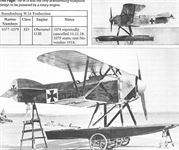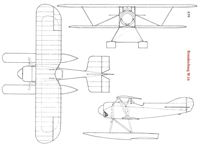
Описание
Страна: Германия
Год: 1916
Fighter
O.Thetford, P.Gray German Aircraft of the First World War (Putnam)
Brandenburg W 16
This single-seat seaplane fighter, designed for station defence, was built during 1916 and was of conventional wood and fabric construction with ply-skinned fuselage and floats. Only three aircraft were built, Nos. 1077-1079. Engine, 160 h.p. Oberursel U III. Span, 9.25 m. (30 ft. 4 1/8 in.). Length, 7.35 m. (24 ft. 13/8 in.). Height, 2.925 m. (9 ft. 7 1/8 in.). Area, 21.35 sq.m. (230.5 sq.ft.). Weights: Empty, 636 kg. (1,399 lb.). Loaded, 896 kg. (1,971 lb.). Speed, 170 km.hr. (106.25 m.p.h.). Climb, 1,000 m. (3,280 ft.) in 5 min., 3,000 m. (9,840 ft.) in 27 min. Duration, ca. 2 hr. Armament, two Spandau machine-guns.
Описание:
- O.Thetford, P.Gray German Aircraft of the First World War (Putnam)
- W.Green, G.Swanborough The Complete Book of Fighters
- C.Owers Hansa-Brandenburg Aircraft of WWI Vol.2: Biplane Seaplanes (A Centennial Perspective on Great War Airplanes 18)
- J.Herris German Seaplane Fighters of WWI (A Centennial Perspective on Great War Airplanes 2)
- M.Dusing German Aviation Industry in WWI. Volume 1 (A Centennial Perspective on Great War Airplanes 84)
Фотографии
-
J.Herris - German Seaplane Fighters of WWI /Centennial Perspective/ (2)
The W16 was an attempt to create a replacement for the KDW that had better maneuverability and handling qualities. It had a larger fixed fin to improve stability and the heavy star-strut arrangement was replaced with a new design that did not obstruct the pilot's view as much. Despite the same power and its much lighter weight than the KDW, it was no faster and its climb rate was actually lower above 1000m. The massive spinner was an attempt to minimize drag.
-
C.Owers - Hansa-Brandenburg Aircraft of WWI. Volume 2 - Biplane Seaplanes /Centennial Perspective/ (18)
The Brandenburg W.16 seaplane fighter was an attempt to produce a seaplane fighter with better handling qualities than the Brandenburg KDW. Only three prototypes were built.
-
H.Cowin - Aviation Pioneers /Osprey/
The single seat Hansa-Brandenburg W 16 floatplane fighter was Ernst Heinkel's second fighter design of 1916, the earlier one being the company's KDW/W 11. Neat and compact, the W 16 incorporated a number of superior design features to its immediate predecessor, but despite this, orders for only three examples, serials 1077 to 1079, were to be received from the navy. Powered by a 160hp Oberursal rotary, the W 16's top level speed was 106mph at sea level. Seen here is the first of the three W 16s, 1077.
-
C.Owers - Hansa-Brandenburg Aircraft of WWI. Volume 2 - Biplane Seaplanes /Centennial Perspective/ (18)
The W16 was the only Brandenburg floatplane design to be powered by a rotary engine.
-
J.Herris - German Seaplane Fighters of WWI /Centennial Perspective/ (2)
The W16 featured a different strut arrangement than the KDW to achieve better field of view for the pilot.
-
C.Owers - Hansa-Brandenburg Aircraft of WWI. Volume 2 - Biplane Seaplanes /Centennial Perspective/ (18)
Brandenburg W.16 SVK Drawing
-
C.Owers - Hansa-Brandenburg Aircraft of WWI. Volume 2 - Biplane Seaplanes /Centennial Perspective/ (18)
Brandenburg W.16 Factory Drawing










